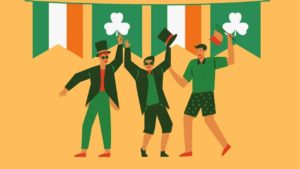Spring Forward During the Pandemic Series Part Two: Staying Healthy During St. Patrick’s Day
By Maisha Ahmed

When you think of St. Patrick’s Day, what images conjures into your mind first? For me, I usually think about the parades, the drinking, and just having a good time with friends and family. In honor of St. Patrick’s Day, which happens to fall on March 17th, today’s blog will not only cover the guidelines of staying healthy during this festive holiday, but also give a bit of background on the history and tradition of St. Patrick’s Day.
History of St. Patrick’s Day
St. Patrick is the patron saint and national apostle of Ireland who is credited with bringing Christianity after escaping as a slave during the fifth century. St. Patrick’s Day has been observed since the ninth or tenth century but the first parade actually took place in America on March 17, 1601. A century later, Irish soldiers who were serving in the English military marched in NYC on March 17, 1772 and from there the keenness for St. Patrick’s Day parade grew in various American cities.
During the next 35 years, there was an increase in Irish patriotism among American immigrants leading to rise of Irish-Aid societies such as Friendly Sons of Saint Patrick. In 1848, several of these Irish-centered societies banded together to form one official NYC St. Patrick’s Day parade. It’s now considered one of the oldest civilian parades with more than 3 million people joining in annually to watch it take place.
The St. Patrick’s Day parade also became a symbol of strength for many Irish-Americans. Most Irish immigrants were considered to be in the middle class up until the Great Potato Famine that hit Ireland in 1845 which led to a massive one million poor and uneducated Irish Catholics pour into America to escape their crippling economic status. At a time where Protestants were the majority, a lot of the Irish immigrants were often discriminated against and alienated for their religious beliefs and unfamiliar accents. They were often portrayed as drunk and violent when they were pictured celebrating St. Patrick’s Day. In time, the American Irish began to unionize and recognize that their growing numbers can be helpful in terms of aiding with political power therefore St. Patrick’s Day parade became a local hotspot for politicians to gain votes.
St. Patrick’s Day Traditions and Icons
Following the history of St. Patrick’s Day, we also cannot forget to include brief history behind the traditions and icons that makes St. Patrick’s Day so unique:
- The Wearing of Shamrock: Wearing Shamrock seems to be a tradition that is dated back to the seventeenth or eighteenth century, an era in which the British invaders oppressed many aspects of the Irish Catholic lifestyle including forbidding them from attending school. In response, things were done under cover such running hedge-schools in secret. Since teaching about religion was also forbidden, teachers would use the shamrock plant to illustrate the message of the Christian Holy Trinity. Saint Patrick in turn used the shamrock as a symbol of the oppressed Catholic population rebelling against the ruling British class. In modern times, wearing a shamrock is seen as a way to celebrate both Saint Patrick and Ireland.
- Irish Music: Music has always been an important element of the Irish culture considering that it was used as a way to remember important events during an era where the Irish couldn’t even speak their own language. Modern Irish bands have popularized the usage of items such as the fiddle, bagpipes, and tin whistle
- Traditional Meal- During St. Patrick’s Day, it is common for many Irish families to gather with their loved ones and eat a traditional meal that consists of corned beef and cabbage.
- Leprechauns- Have you ever wondered why leprechauns were associated with St. Patrick’s Day? They were first written in old Irish fables so it just makes sense to be associated with the Irish culture. Leprechauns are known for their trickery to protect their treasure and although they have their own holiday, they are also celebrated on the same day as St. Patrick’s Day
Staying Healthy During St. Patrick’s Day
As noted above, St. Patrick’s Day is celebrated with good food and drinks. But how can those who are trying to keep their new year’s goal of staying healthy or those doing their spring cleansing of their body celebrate St. Patrick’s Day in a way that aligns with their motives? Below are some tips to stay healthy:
- Don’t Start the Day Hungry: I used to not eat anything beforehand if I knew that I would be consuming a large meal later on, but I realized that it’s not such a great idea because it did lead me to overeat as well binge eat late night snacks.
- Choose Cabbage Over Corn Beef: As stated previously, the traditional meal for St. Patrick’s Day consists of cabbage and corn beef but eating veggies first is a good way to satisfy your appetite as it often has low calories while making you feel full at the same time. Listed below is a recipe for a Shamrock Salad that you could try out:
- Ingredients: 1 bunch thin asparagus spear, 5oz sugar snap peas trimmed, 5oz snow peas trimmed, 5oz shelled fresh peas, 1.7oz rocket, 1.7oz baby spinach, 2 sticks celery sliced
- Dressing Ingredients: 1 garlic clove, 1 tablespoon of extra virgin olive oil, 2 teaspoons white vinegar, 1-2 teaspoon grainy mustard
- Directions: Remove woody ends from asparagus and cut into equal lengths. Cook the peas and asparagus in boiling salted water for around 2 minutes or until just tender but still crisp. Do not overcook them and when removed from water refresh them in a bowl of iced cold water. Drain, pat dry and place into a bowl with rocket, spinach and celery. Combine the dressing ingredients, add salt and pepper to taste and mix well through. Pour over salad, and toss.
- Watch Your Portions: This advice goes well with any diet plan and not just specifically for St. Patrick’s Day. It’s okay to indulge in whatever you want to eat as long as you are careful about the portion size.
- Drink Smarter: The best option would be to keep yourself hydrated and full with water but if you’re going for the beverages, some of the recommended drinks would be light beers, red or white wine, or drinks mixed with soda water.
References:
https://web.noom.com/blog/6-easy-ways-to-stay-healthy-this-st-patricks-day/
https://www.food.com/recipe/greens-salad-shamrock-salad-224563
https://www.history.com/topics/st-patricks-day/st-patricks-day-symbols-and-traditions
https://www.history.com/topics/st-patricks-day/history-of-st-patricks-day
https://www.ireland-information.com/saintpatricksdaytraditions.htm

